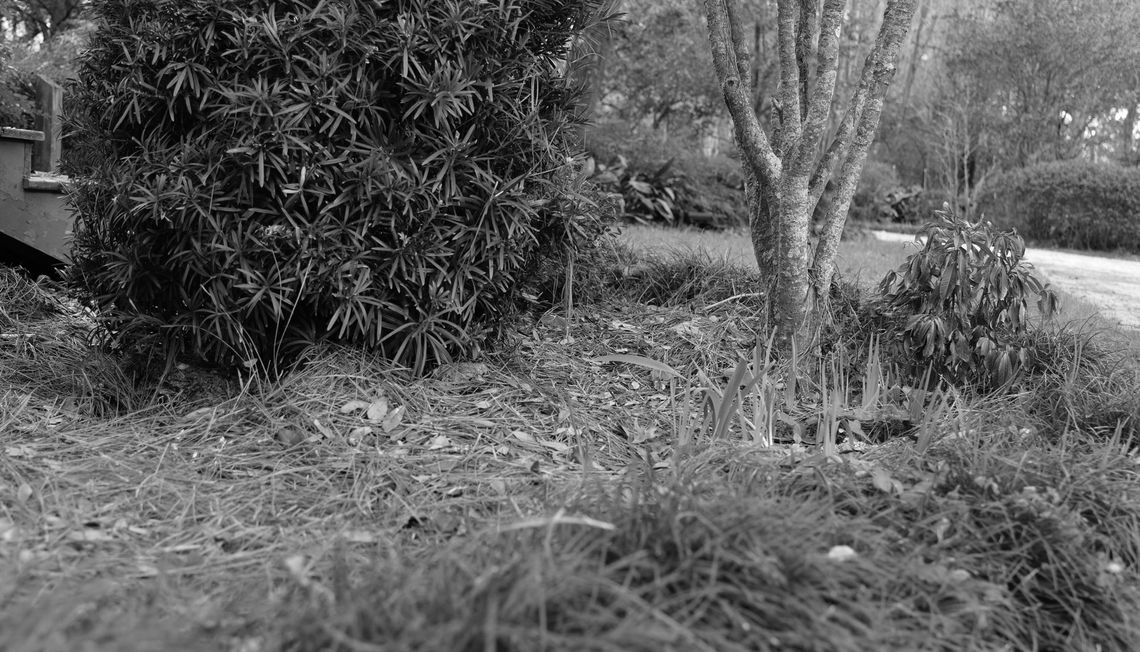Picture this: a lush landscape brimming with plants that stay attractive year-round without you, the gardener, having to lift a finger. There’s no grass to cut, and weeds are kept at bay through clever use of groundcovers and hardscaping. Sounds great, right?
We hate to be the bearer of bad news, but a low-maintenance landscape like this is virtually impossible to achieve in Louisiana. Our warm, wet climate and long growing season promote explosive weed growth. Even desirable plants can quickly outgrow their appointed spaces.
You could fill your entire landscape with gravel, decorative boulders and paved surfaces, and you would still face the need for periodic maintenance. Wind, rain, wildlife and mowing would carry dirt particles and weed seeds into rocks and around pavement. We simply can’t escape the reality of prolific weed growth here in Louisiana.
So what is a busy person without much time for lawn and garden maintenance to do? While it’s not feasible to eliminate all landscape chores, you can lighten the burden by following the three steps outlined below. If you choose the right plants and place them carefully, you can create a landscape that looks nice and reduce the amount of upkeep you have to fit into your hectic schedule.
Step 1: Tree placement Take note of where you have trees or decide where you would like to plant some. Trees have a profound effect on the look and feel of landscapes, as they take up quite a bit of space and can live for many years. They need regular watering during establishment and in times of drought, but otherwise, trees aren’t incredibly demanding plants. They also provide benefits such as wildlife habitat, shade and improved property values.
Whether you have a spacious yard or a small lot, there are trees of all shapes and sizes to choose from. You may want to select species with innate storm resistance such as bald cypress, pond cypress, Southern magnolia and live oak. Some trees have ornamental qualities — for example, Japanese maple leaves turn brilliant hues of red and orange in the fall, and Taiwan cherries sport magenta flowers in late winter and early spring.
If you don’t want to rake a bunch of leaves, opt for evergreen selections over deciduous ones.
Place smaller trees closer to structures that can shield them from strong winds. Make sure to leave plenty of space around larger trees to avoid branches encroaching on your home or other structures.
Step 2: Foundation plantings After you’ve figured out tree placement, the next point to consider is shrubs. We refer to shrubs as foundation plantings for a few reasons. They often are near the foundation of homes, structures and other built items like driveways and fences. They soften the transition between nature and the built environment. And, like trees, shrubs are long-lived plants that form the backbone and influence the flow of gardens. They’re a constant in the landscape.
When deciding what shrubs to plant, think about what your garden looks like in the middle of winter, when deciduous shrubs and trees lose their leaves but evergreens remain vibrant. If the balance seems off and your winter landscape is a collection of leafless sticks and stems, you may want to plant a few more evergreen shrubs. A good mix to aim for is 75% evergreen and 25% deciduous.
Focus on tough plants that thrive in sun or shade — whatever conditions you have in your yard — and that don’t require frequent pruning. Try to select shrubs with different bloom times to keep the landscape lively yearround.
Camellias are a great foundation planting for Louisiana landscapes, particularly the sasanqua and hiemalis species. They tolerate full sun or part shade, and their fall and early winter flowers provide forage for honeybees and other overwintering pollinators.
Other foundation planting options to consider include Japanese yew, which can be used to form a living privacy screen; Florida sunshine anise, which brightens shady areas with chartreuse foliage; and dwarf hollies, which work great for short hedges.
Step 3: Mulch, groundcovers and hard surfaces For effective but passive weed control, you can rely on mulch and groundcovers.
Construct wide mulch beds around your trees and foundation plantings. Don’t feel pressured to fill your mulch beds with annual color plants or trim them with border grass. The mulch itself offers enough of a color and texture contrast from the lawn and other features of the landscape. It also is an effective strategy for suppressing weed growth, retaining moisture and adding organic matter to the soil — all of which benefits the health of your plants.
If you would rather plant groundcovers instead of applying mulch, keep in mind that common shorter species such as dwarf mondo grass will still allow a few weeds, vines and tree saplings to sprout through them — meaning they will require occasional maintenance. For an easiercare groundcover, you can try a taller, more vigorous plant like aspidistra, also known as cast iron plant.
You also can incorporate elements like gravel, pavers, concrete and decorative rocks into the landscape to limit the amount of grass you must maintain. Just keep in mind that weeds will inevitably sprout in and around these items. Be prepared to hand pull them or treat with herbicides to maintain an orderly appearance.


